Service Desk and Help Desk software are essential tools for organizations to provide efficient and effective customer service, but also for end users, such as your company’s employees. With features such as ticket management, self-service options and analytics, this software streamlines operations and improves the overall service experience. Discover the best service desk and help desk software!
Differences Between Best Service Desk Solutions and Helpdesk Tools
What You Need in a Helpdesk Tool and Service Desk Management Tool
Top Service Desk Software
- SolarWinds Service Desk (our pick)
- SolarWinds Web Help Desk
- Atera
- Zoho Desk
- Spiceworks Help Desk
- Freshdesk
- AnswerDash
- ManageEngine ServiceDesk Plus
- Zendesk Suite
- BeyondTrust
- Oracle Service Cloud
- Apptivo
- Dezide
- BOSS Support Central
- Help Scout
- TOP desk
- Dixa
- Acquire
Tools for Managed Services Providers
The Best Service Desk/Help Desk Tool
The popularity of the cloud has resulted in an influx of IT administration tools, all of which are still relatively new. Sorting through the vast range of programs on the market, working out the differences between them, and selecting the right one for you can be difficult. I’ve put together this guide of the top IT helpdesk tools and top service desk tools to save you time and assist you in making an informed decision. Before I leap into the product list, I’ll first outline the main functions of helpdesk tools and service desk tools, and the key differences between the two.
- Differences Between Best Service Desk Solutions and Helpdesk Tools
- What You Need in a Helpdesk Tool and Service Desk Management Tool
Differences Between Best Service Desk Solutions and Helpdesk Tools
While there is some overlap between helpdesk management tools and service desk software tools, there are key differences worth noting. In the simplest of terms, a helpdesk enables agents to address customer support queries in both a reactive and collaborative way. Service desks, on the other hand, offer a more proactive way of managing customer service operations. So, although both helpdesk support tools and service desk software tools focus on customer service, they approach it in a very different way.
In terms of how the two relate to each other, a service desk usually features a helpdesk of some kind, which typically incorporates ticketing utilities and the ability to log service requests. The helpdesk serves as the following:
- A centralized point of contact for all incoming issues
- An information request manager
- A service level tracker
The aim of these features is to provide a personal, authentic, and engaged customer service experience. These attributes make the helpdesk a crucial part of any service desk management tool.
What You Need in a Helpdesk Tool and Service Desk Management Tool
Before going on to my list of the best service desk tools and helpdesk tools, I’ll detail what you should expect from the program you choose. A helpdesk and service desk tool should be built on five key principles: automation, collaboration, integration, self-service, and reporting.
- Automation. Let’s start with automation. A good service desk should be automated to some extent, with several features requiring little to no manual intervention on your part. Here are some examples of features you might expect to be automated: receiving incoming queries, rerouting simple and low-impact queries to an integrated self-service knowledge base, and problem identification.
- Collaboration. A service desk should be collaborative by nature, with shared inboxes for incoming queries, so you and your team of agents can collaborate on addressing each one as efficiently as possible. This collaborative element should include the ability to sort, tag, prioritize, and reassign queries to the appropriate or available agent.
- Integration. Service desks should offer robust APIs and integration services, which let them integrate with your other IT management processes. Your service desk is just one part of your IT system, and as such should be able to integrate easily with other applications, like Salesforce and Slack.
- Self-service. This is an obvious aspect of the service desk. Self-service features should save you and your team time and effort by allowing users to essentially serve themselves. This might take the form of FAQs or a knowledge base. Another example might be a ticketing system connecting common queries to public material, like a blog or guide on the subject.
- Reporting. Lastly, there’s reporting. Tracking how your service desk is performing is key to improving it, so an effective service desk tool should be able to report on the following metrics:
-
- Agent response time
- Ticket volume
- Ticket response time
- Customer satisfaction
- Net Promoter Score
By tracking these metrics, you’ll be better able to stay on top of SLAs.
Top Service Desk Software
Now that we have covered the service desk tool requirements, I’ll get into my picks for the top helpdesk software tools and service desk software tools on the market today.
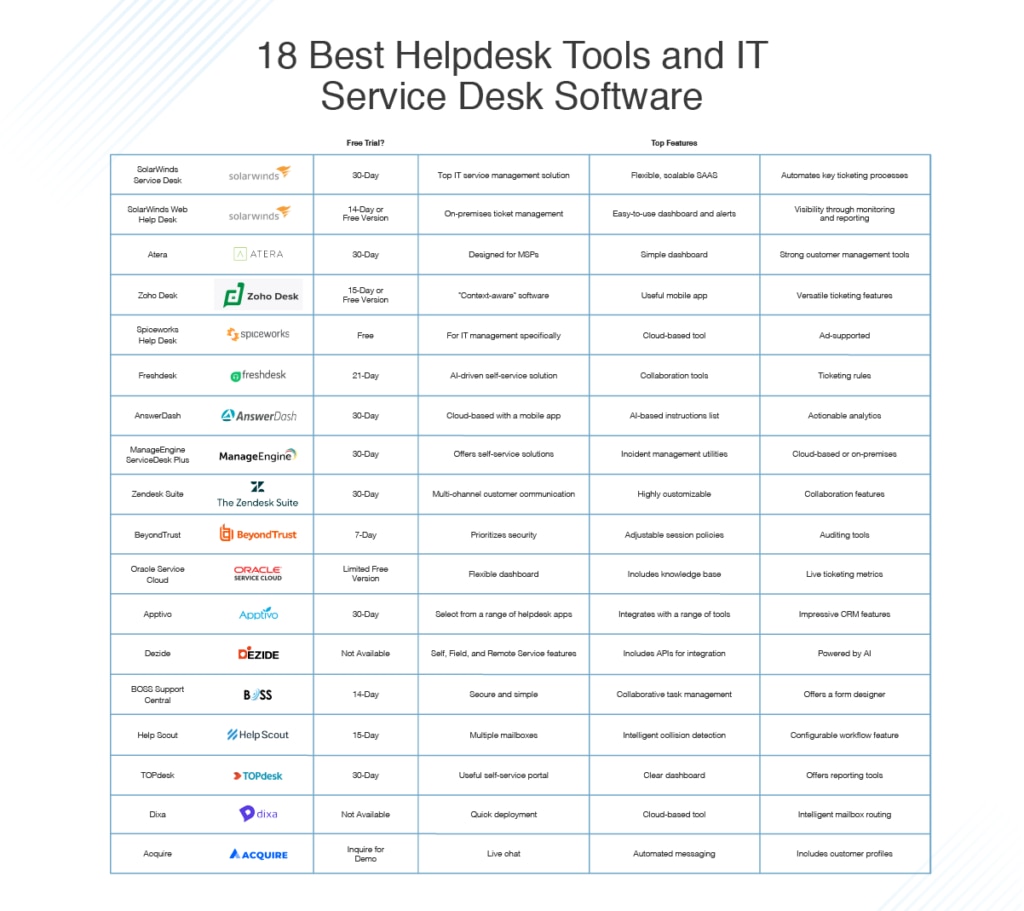 © 2021 SolarWinds Worldwide, LLC. All rights reserved.
© 2021 SolarWinds Worldwide, LLC. All rights reserved.
To summarize, for those of you who don’t have time to give the whole guide a read, I concluded SolarWinds Service Desk (SD) is the best tool available. It offers IT asset management, a knowledge base, change and problem management utilities, and a service catalog, and it benefits from being delivered in software-as-a-service format. Overall, it combines power with functionality and user-friendliness to give it the edge over its competitors.
For more details on how I came to this conclusion, plus the benefits and pitfalls of other top offerings, read my list below.
1. SolarWinds Service Desk (Free Trial)
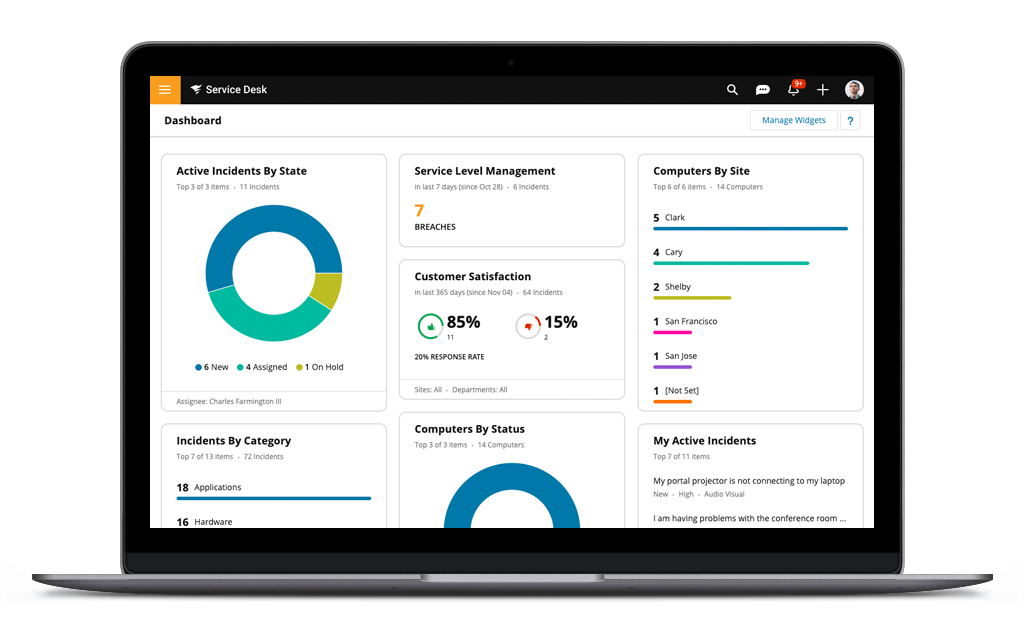
© 2021 SolarWinds Worldwide, LLC. All rights reserved.
SolarWinds Service Desk is an IT service management (ITSM) solution bursting with intelligent, powerful features. It includes an employee service portal with incident management, IT asset management, and problem management functionalities, which combined give this product a real edge. There’s a lot to love about SolarWinds Service Desk; here, I’ll focus on the features I like the most.
Firstly, it’s delivered in SaaS format, which means there’s no installation process or even installation requirements. This can save you a lot of time. Even so, some administrators prefer applications to be installed on their own servers, and SolarWinds has taken this into account. Service Desk offers the flexibility of being able to be installed on a server, by special arrangement.
The tool functions as both a service desk and a helpdesk. It boasts helpdesk support tools, including a ticketing system for tracking solutions, a self-service portal for customers, and a knowledge base utility for you to create your own guides and system documentation. The knowledge base and self-service portal are particularly useful because they empower customers to serve themselves, reducing the need for heavy involvement on your part. Moreover, you can include anything you like in the knowledge base, accounting for all the regular queries. You could even use the knowledge base to train your own staff by providing training material and best practice guides.
Scalability is another major benefit. With SolarWinds Service Desk, you’re charged according to a per-agent, per-monitored-device system. In practice, this makes scaling easy, so this tool can be used by small and big organizations alike.
Service Desk is a highly versatile program and is fully compliant with ITIL standards. This means it allows you to track the planning, implementation, and monitoring of system extensions. And it can be integrated with more than 200 cloud applications, including OneLogin, Microsoft Azure, Nmap, Okta, and Google SSO.
As I mentioned earlier, automation is a fundamental aspect of any successful service desk. Accordingly, SolarWinds Service Desk automates a range of processes across your service management strategy, minimizing repeats in tasks and affording you the utilities needed to build rules. These rules work to boost overall efficiency by automating ticket routing, alerts, approvals, and much more.
The advanced ticket routing feature is one of Service Desk’s most noteworthy automation features. This utility gets the right tickets to the appropriate teams quickly, by combining AI technology and categorical groupings to facilitate routing processes.
The tool’s automated workflows are also worth noting. Workflows can be a tricky business, and it’s not uncommon for work to slip through the cracks. Service Desk’s automated workflow feature lets you formalize processes within a department, aligning teams by eradicating bottlenecks and making sure no issue is overlooked. The flagging of critical events can also be automated—you can establish notification rules, so you and your team are alerted to critical events, or events that might breach SLAs, immediately.
SolarWinds Service Desk supports change management processes, encompassing software monitoring, software rollout, and wider enterprise control. This utility goes with the tool’s configuration management database (CMDB), which tracks all the software running on your network. It logs all the relevant details, including interaction between software elements.
While this is a highly automated program, equipped with machine learning processes, it’s possible for users to take a more manual approach. The asset and problem management aspects of Service Desk have reporting functionalities, which allow you to intervene when called for. You could, for example, activate, extend, or refine how much automation is involved in your service desk strategy.
One of the many things I love about this software is the dashboard. A well-designed dashboard layout can make all the difference in how you engage with a program. Service Desk has a clean dashboard with an intuitive design, which makes data interpretation easy. Everything on the main dashboard is important, so you won’t find yourself sifting through meaningless data. Instead, you get an overview at a glance, which is beneficial in terms of saving time. If you want to give SolarWinds Service Desk a try, a 30-day free trial is available during which the tool is fully functional.
2. SolarWinds Web Help Desk (Free Trial)
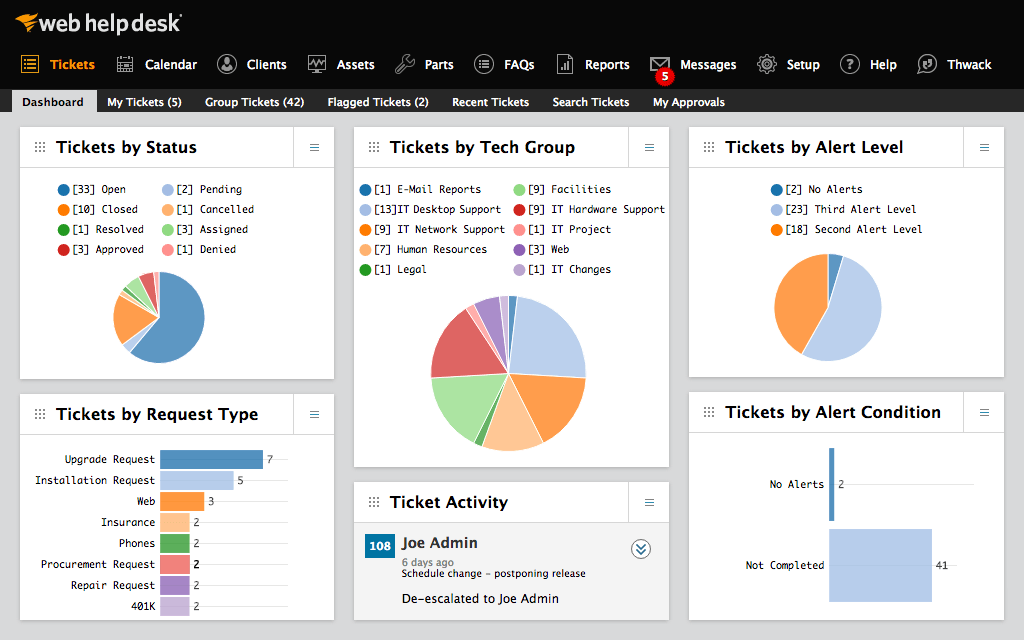
© 2021 SolarWinds Worldwide, LLC. All rights reserved.
SolarWinds also offers Web Help Desk (WHD), an on-premises tool you install on your web server. There are several key differences between SolarWinds Web Help Desk and SolarWinds Service Desk. While both offer IT asset management, ticketing, a knowledge base, change and problem management, and service portals, Service Desk has several features Web Help Desk lacks. These include CMDB software, a service catalog, release management, and localization into multiple languages.
Essentially, WHD is a minimized version of SD, and it serves as a ticket management system. For those businesses whose requirements are on the smaller side, you might find WHD a better fit than SD. WHD offers all the key utilities you expect of IT helpdesk ticketing tools, in a no-nonsense way.
Like Service Desk, Web Help Desk benefits from a highly intuitive and cleverly designed dashboard. I especially like the variety of graphing options available, and the way the dashboard is divided up into a clear, easy-to-read format, with tabs including “Tickets,” “Calendar,” “Clients,” “Assets,” “Parts,” “FAQs,” “Reports,” and “Messages.” This makes everything easy to find.
The dashboard also serves as an alerts system, notifying you if there’s a potential breach in performance targets, with the graphical elements drawing attention to any failure. Via the console, you can establish date-related alarms, which will remind you of any upcoming contract deadlines.
As helpdesk support tools go, this one offers a significant number of automated functionalities. Service request management can be made fully automatic, encompassing the process of ticket creation, assignment, routing, and escalation. In addition, you’ll benefit from the automated conversion of emails to tickets—this feature uses IMAP, Exchange, and POP protocols to convert service request emails into helpdesk tickets.
The monitoring and reporting utilities of this tool are certainly worth a mention. Built-in reports and dashboards track performance according to SLAs, and reports give you visibility into technician performance, customer support needs, and ticket status. On the subject of SLAs, you can establish “SLA breach approaching” notifications and date-specific reminders, so you’re always up to date. You can also customize automated escalation and de-escalation workflows.
As with SolarWinds Service Desk, Web Help Desk comes with a built-in knowledge base, which lets you create and maintain articles and guides. This feature encourages end users to help themselves instead of using up agent time on common queries.
Another thing I like about this tool is the ability to create user satisfaction questionnaires when a ticket has been completed. This helps you gain a clear picture of performance and identify any weaknesses in the system.
SolarWinds WHD can be integrated with other SolarWinds products, including SolarWinds Network Performance Monitor, SolarWinds Network Configuration Manager, and SolarWinds Server & Application Monitor. By combining these products, you can establish a highly comprehensive network and server monitoring solution.
Web Help Desk can be installed on Windows, Windows Server, Linux, and Mac OS. A free 14-day trial is available. There’s also a free version of WHD, but the features are limited.
3. Atera
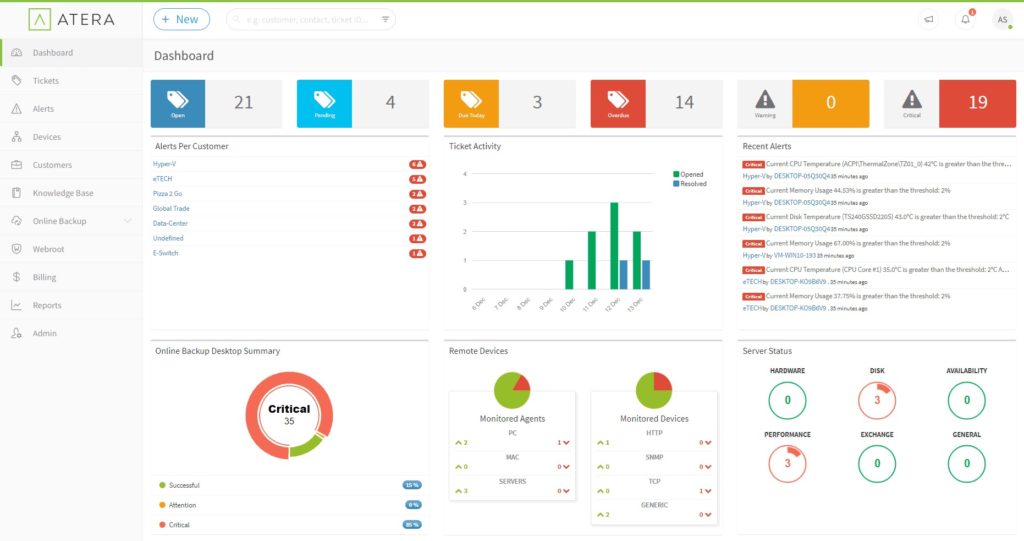
© 2021 Atera Networks Ltd. All rights reserved.
Atera’s remote monitoring and management (RMM) solution aims to unify your MSP business, and it offers some impressive utilities. These include ticketing and customer satisfaction surveys. Though this tool was designed primarily for MSPs, it also serves as an efficient and intelligent helpdesk.
The dashboard for Atera is wonderfully simple, making everything clear and easy to read. In fact, simplicity is what I like most about this tool—it’s high-functioning and powerful without sacrificing user-friendliness.
The help ticketing feature of Atera designates tasks for tracking to each operative and delivers an outline to team leaders. Like the SolarWinds tools, Atera includes a knowledge base platform, which allows you to build up a range of log solutions, so operative time isn’t wasted on simple, common queries. The knowledge base also serves as a platform for service checklists and solution scripts.
There’s so much to appreciate about Atera’s approach to customer relationship management. For a start, all customer-related data is stored centrally, in one place, along with all the appropriate RMM and professional services automation data. With a single view of contacts, SLAs, contracts, devices, and tickets, this is an extremely efficient and user-friendly console. There’s even a repository for encrypted passwords and miscellaneous attachments.
In terms of ticketing, you’ll have visibility into all your tickets and their due dates, and an indication when a ticket is overdue. The dashboard will also tell you whether the ticket is open or closed, who it has been assigned to, and whether it’s critical or not.
The drawback to this tool is it was designed with MSPs in mind, so you may be wasting some of its utilities if you only use it for helpdesk purposes. A free 30-day trial is available, giving you access to all the premium features, and no credit card details are necessary.
4. Zoho Desk
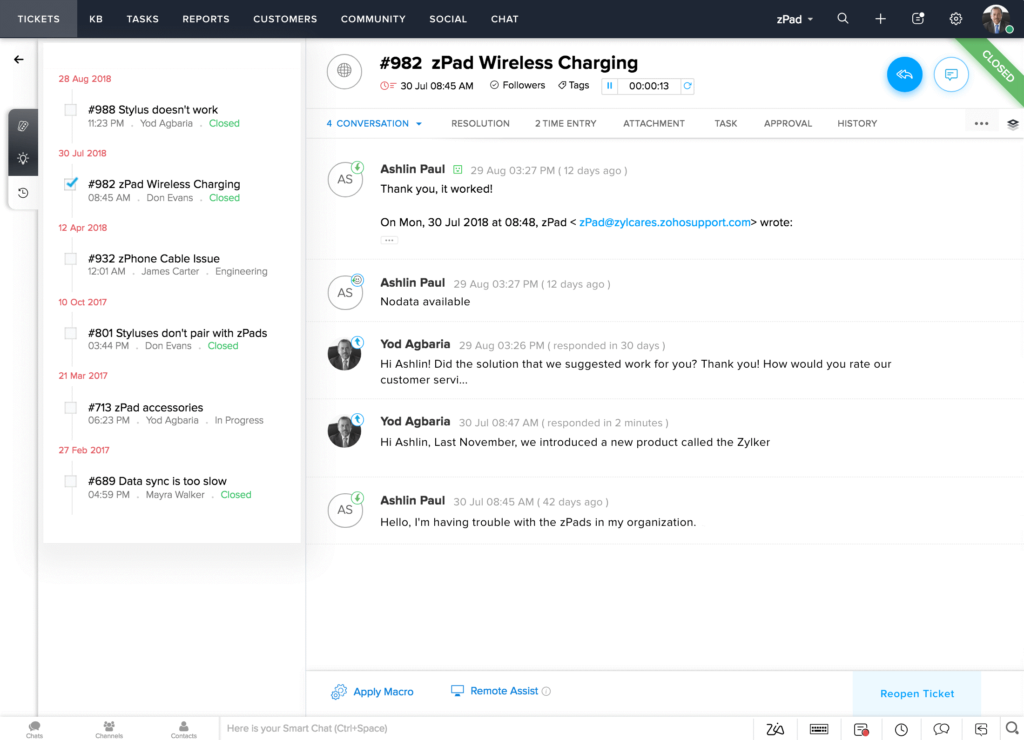
© 2021 Zoho Corporation. All rights reserved.
Zoho Desk describes itself as the industry’s first “context-aware” helpdesk provider. This tool, which is extremely modern and accessible, is accessed via the cloud. By far the most impressive thing about Zoho Desk is its mobile application, which lets agents stay on top of customer support from anywhere.
The app is available for Android and iOS, and it gives you real-time visibility into ticket updates. You can decide which notifications you receive—for example, you might choose to be alerted to accounts, tickets, contacts, responses, and/or internal comments. Comments are presented as conversations within the application. There are separate tabs for notifications, tickets, feeds, contacts, and settings.
The mobile app also features work modes, which enable you to arrange tickets according to either when they’re due or customer type. These are sorted automatically based on your specifications, so you have constant and instant insight into which tickets are most critical. On the app, you can also view customer information from the Zoho CRM, including contact details (phone number, email, and address) and details of previous interactions.
This is a highly versatile mobile application, giving you access to the features you need most when you’re on the go or away from the keyboard. You can create tickets, assign status, link CRM contacts, alter the priority, update the status, and assign to owners. The app even features response templates, so you don’t have to waste time typing out new content every time you reply to a ticket. You can upload attachments to these replies and create confidential responses. I really appreciate the mobile application showing ticket interactions as a conversation, like a typical communication platform. This made the reading experience intuitive and easy, and it’s well suited to the mobile format.
But there’s more to Zoho Desk than the mobile application. The program supports departments within an organization and external customers and is multi-channel. This means customers can submit queries via email, social media platforms, live chat, phone, or web form. All these queries appear within the program’s console, as a unified view. Self-service is a key aspect of any good helpdesk program, and Zoho Desk does this really well. It uses a trouble ticketing system, which allows you to create your own help center, complete with a knowledge base. This knowledge base serves as a repository of articles, FAQs, and guides, so your customers can find the answers to their queries themselves. You can also establish communities and forums where customers interact with each other and problem-solve issues together. And of course, if your customers can’t find the answers themselves, they can connect with you via live chat instantly.
Gaining insight into how your ticketing system is performing is crucial to continuous improvement. Zoho Desk lets you view which channels have the highest ticket traffic rates and the average resolution time for each channel, helping you identify and eradicate bottlenecks. You can also create customer reports, which can be scheduled and exported. Built-in dashboards track your service with common metrics, but you can add statistics by customizing your reports.
Zoho Desk also provides an integrated tool called Advanced Analytics, which essentially gives you access to predefined reports. The drag-and-drop report builder lets you generate numbers and data quickly, and Zoho Desk can email you reports on an automated basis, according to the schedule of your choosing.
The only drawback of Zoho Desk the lack of flexibility to choose between using it in the cloud or on-premises. For those of you who prefer an on-premises program, this won’t be for you. On the other hand, due to its location in the cloud, Zoho Desk can easily interface with other Zoho products, like Zoho CRM, Zoho Books, and Zoho Bugtracker.
If you want to give Zoho Desk a try, you can check out the free plan. It’s fairly limited, but it should give you a good sense of the program. There are also three paid plans available—Standard, Professional, and Enterprise.
5. Spiceworks Help Desk
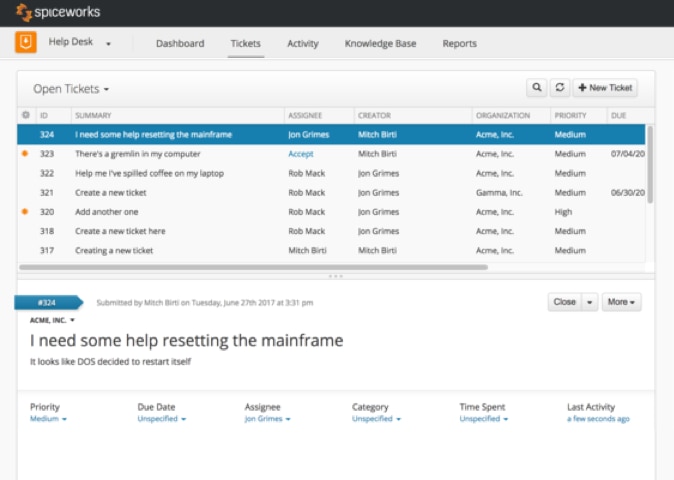
© 2021 Spiceworks. All rights reserved.
There are a lot of helpdesk ticketing tools in IT, but only a few stand out. These include Spiceworks Help Desk. One of the great things about this free program is how quickly you can set it up—in fact, you can download it and be up and running in a matter of minutes. This program was specifically designed for IT management, and it lets you track technology issues in real time.
Spiceworks Help Desk is a cloud-based program, but you can download an offline version for Mac OS or Windows. Having this flexibility is useful, and it makes this tool suited to all administrators, no matter their view on cloud-based technologies. This program can be integrated with Spiceworks’ network monitoring tool, which is also free. By combining the two, you can create a decent comprehensive toolkit without having to spend a dollar.
There are benefits associated with both versions of this program. The online helpdesk is accessible from anywhere, provided you have an internet connection. There’s barely any setup, no maintenance requirements, and no server procurement. You get standard helpdesk management functionalities, including email, reporting, ticket management, a dashboard and customizable portal, custom ticket attributes, ticket rules, alerts, and monitors. It’s generally very customizable, with lots of options for streamlining tickets, offering user support, and team collaboration with ticket rule automation. Moreover, the cloud version integrates with Active Directory, so your users can log in with AD credentials.
The self-hosted version of Spiceworks Help Desk functions slightly differently, though you get access to all the features of the online version. With the self-hosted version, these features simply exist on your network. You get full control, because you aren’t dependent on an ISP—if your internet connection fails, you can still access the platform. The installation for this version is easy. You get an OVA file, so you just need to make sure you have a supported hypervisor. You won’t need any new hardware.
Spiceworks also offers the Help Desk Mobile App, which gives you the latest updates on your tickets and delivers push notifications, so you’re never out of the loop. A mobile application feature is unusual for a free tool, making this especially impressive. The app is available on Android and iOS devices, including tablets and iPads.
The dashboard for Spiceworks Help Desk is great: the information is laid out clearly, in a way that’s both dynamic and easy to read. You’ll have visibility into average first response time, average ticket close time, labor statistics, which tickets are open and closed, and more. You can even assign role types to your team members, to determine who sees what. This means your agents won’t have visibility into anything not relevant to them.
The biggest disadvantage of Spiceworks is it’s supported by ads. There’s usually an advertising panel in the dashboard, which some people find irritating. Unfortunately, there’s no ad-free version, so if you think this is likely to get on your nerves, then Spiceworks isn’t for you.
6. Freshdesk
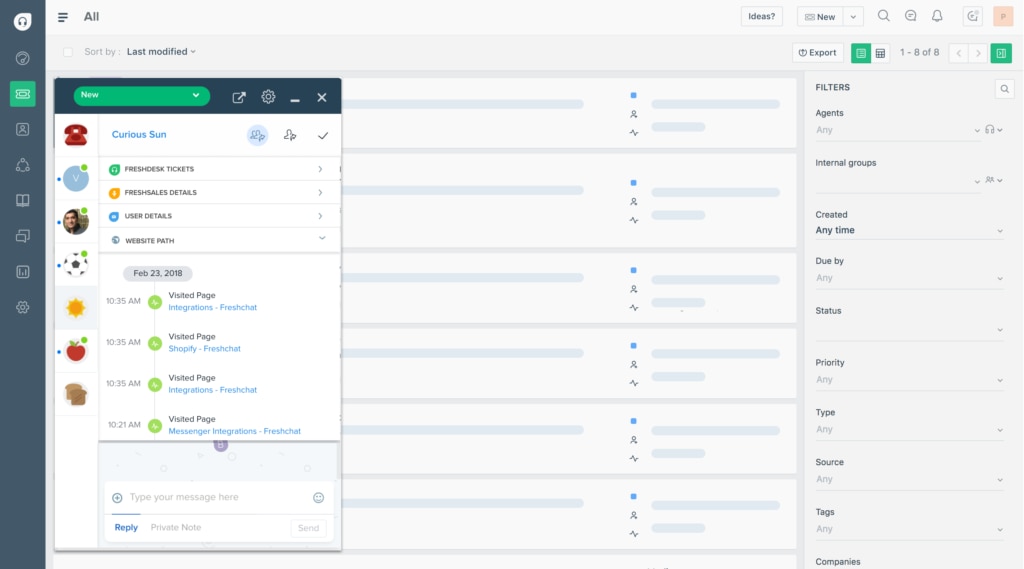
© 2021 Freshdesk. All rights reserved.
Freshdesk is an AI-driven, omnichannel or self-service solution with impressive utilities. If you’re especially interested in tools with a focus on self-service, then Freshdesk is an option to consider. It includes a knowledge base, a community forum, document indexing, and an access portal. By publishing expert advice, you can give users the information needed to solve their own queries in many instances, reducing the labor on your end. Technical support staff can post to the community forum, which I like.
As an IT helpdesk ticketing tool, Freshdesk is very effective. It can convert incoming communications into tickets, and it lets you prioritize, categorize, and assign them according to your specifications and requirements. The system was designed to save you time and effort by simplifying the ticketing process; every email, feedback, chat, or call can be converted into a ticket, so there’s no need to switch between platforms or tools. You can also save replies as “common tickets,” so they can be reused without having to type up new content.
Collaboration is another key part of the Freshdesk solution. The team inbox is great for collaborating and boosting agent effectiveness: you can prioritize tickets with keywords, assign tickets to specific agents or groups, and filter tickets according to certain properties. Collision detection takes the hassle out of collaboration by giving you visibility into who’s working on what, thereby ensuring there’s no overlap. And the agent collision detection feature can merge related tickets, freeing up time. Moreover, if you receive multiple queries regarding the same issue, these are linked together and sent to one agent, certifying the solution is consistent.
Freshdesk features a logging system where you can record and store everything from emails and chats to phone calls and web form ticketing. Simple problems that are queried often can be managed with automated replies. In terms of SLA management, Freshdesk lets you establish rules pertaining to when tickets must be replied to, when they have to be solved, and estimated communication times. This enables you to monitor and measure how well agents are performing, as well as making deadlines and expectations crystal clear. Work can be redistributed, or more staff acquired, according to the results of SLA performance metrics. In general, SLA management is flexible with Freshdesk, letting you configure different SLAs for different groups (e.g., agents, products, or companies).
Freshdesk has some unique features, including its Team Huddle platform, which creates a conversation record for a team. This means team members with a range of skills can collaborate to solve more complicated tickets. Subtasks can be allocated to specific technicians and are tracked and recorded according to a parent-child hierarchy. If another department’s insight is required, technicians can send job requests, making the records associated with the ticket available to the relevant department.
Freshdesk is a great tool, but its mobile application could offer greater functionality. There are a few versions of Freshdesk available, and they can be paid for on a monthly or yearly subscription basis. If you want to get a risk-free idea of whether this program is suited to your needs, you can access a 21-day free trial of the Estate version, which is designed for large teams.
7. AnswerDash
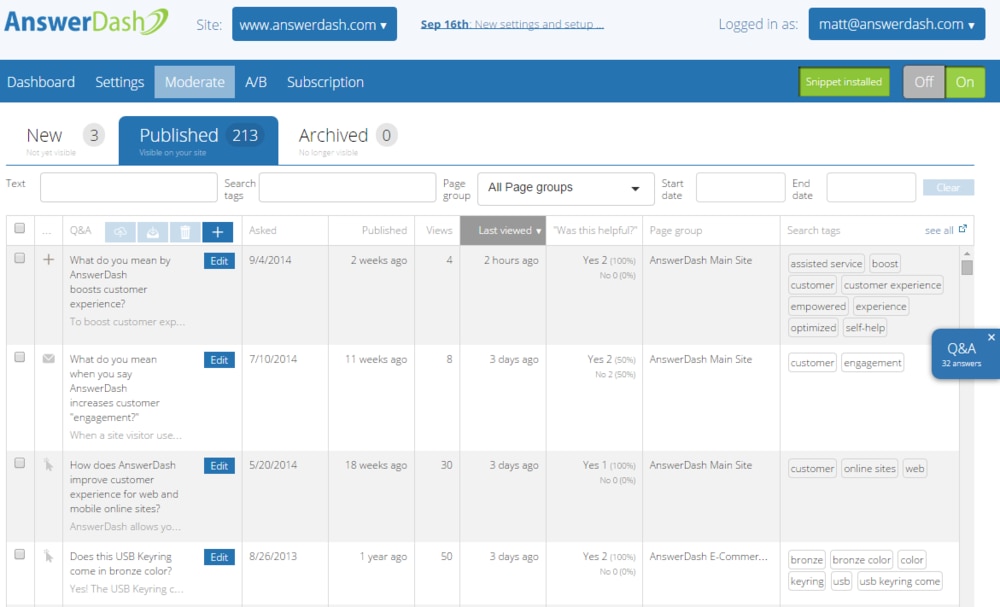
© 2021 AnswerDash. All rights reserved.
AnswerDash is a cloud-based helpdesk tool, with a design strategy aimed to reduce the need for interactions with support staff as much as possible. This saves time, resources, and money. I was dubious about how this strategy would pan out initially but found AnswerDash has some notable advantages and is generally successful.
Let’s start with it being a cloud-based platform, which comes with the obvious benefit of accessibility. Provided you have an internet connection or mobile data, you can access AnswerDash over the web or via your mobile application. The AnswerDash helpdesk portal can be integrated with your own intranet or website, which is useful. But the most impressive thing about this tool is the AI, which uses probabilities to generate the appropriate outcomes and outgoings.
The tool’s AI maintains a list of instructions, which are executed under certain circumstances, according to a fact database. The instructions list, otherwise known as an inference engine, provides alternatives linked with probabilities. Inference actions are determined by the ordered probability list. In practice, this AI system delivers support functions very effectively. The AI algorithms predict and deliver content personalized to the user’s profile.
Another thing I like about AnswerDash is the actionable analytics. You get real-time data, which provides you with significant insight into where support tickets originate from, sales conversions, and abandonment. You’re also afforded cross-functional team insight into the questions being asked, where they’re being asked, and what customers are doing after they’ve asked the question. This helps to inform how agents offer support.
The mobile application is another nifty feature of AnswerDash. Customers can access all the help they need via the app, and their mobile help experience is customized to fit with your overall brand, keeping their experience consistent and unified. The app also uses AI to deliver content relevant to the specific page the user is on, so all the content is appropriate to their needs. The AnswerDash app is easy to integrate: just add the mobile SDK with a couple of lines of code, and your Android and iOS applications will be ready to go. If this sounds tricky, don’t worry—AnswerDash offers plenty of development support and content to help you.
As I mentioned earlier, AnswerDash has a focus on helping customers to help themselves; however, this won’t necessarily resolve every problem. To make this process as effective as possible, your organization needs to contribute to a database of problems and solutions. The input of your experts will establish a solution capable of addressing more issues.
Still, some problems cannot be solved through self-service or AI—for example, those from an uncommon user error. Even the most experienced technical experts will face unusual queries that can’t be addressed by AI or the knowledge database. In this case, AnswerDash quickly routes queries to your agents via its chat tools.
The major weakness of this solution is also its main strength: its self-service focus. This comes with advantages in terms of reducing team labor, but it requires a lot of input and makes you highly dependent on AI, which is not always reliable. If self-service is a priority for you, then this tool might be suited to your needs.
8. ManageEngine ServiceDesk Plus
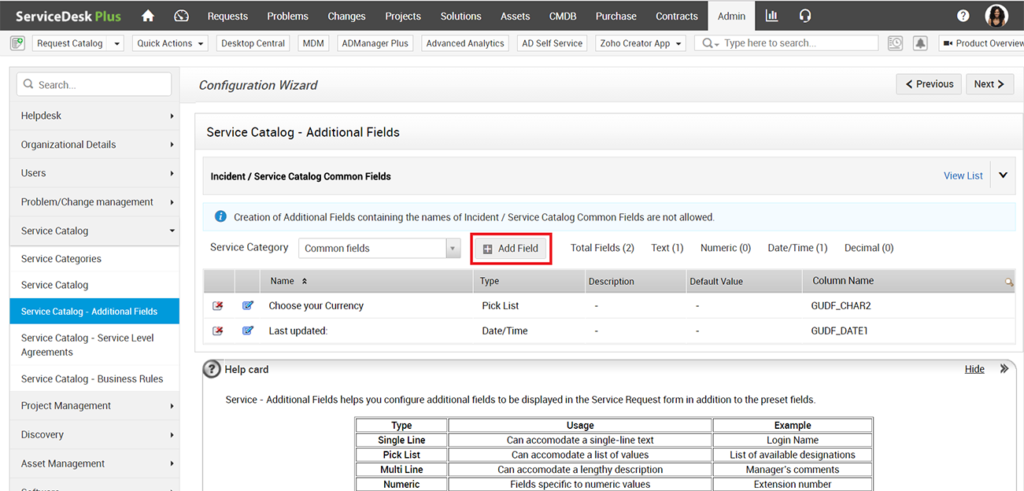
© 2021 ManageEngine. All rights reserved.
ServiceDesk Plus by ManageEngine is another notable service desk management tool with a reputation for quality. It accounts for incident management, problem management, change management, and asset management, in a solution provided by an industry-leading developer. There’s plenty to like about ServiceDesk Plus, including the flexibility to access it as both a cloud-based and an on-premises service. The installed version is available for Windows and Linux.
ManageEngine is owned by Zoho Corp, responsible for Zoho Desk, but chiefly operates as a separate provider. However, Zoho Desk and ServiceDesk Plus can be downloaded from both provider websites.
ServiceDesk Plus aims to deliver a solution that prioritizes not just problem solving, but overall customer service and customer experience. This means offering detailed and extensive visibility, centralized controls, and a service to minimize the likelihood of downtime. The incident management utilities, for example, have been designed to improve the productivity of agents, reduce potential outages, certify you’re meeting your SLAs, and manage the lifecycle of your tickets from start to finish.
With problem management functionalities, you can customize tickets, classifying them and analyzing the root cause, so you can reduce repeats. This saves time down the line, making your system more efficient and more economical every day. ServiceDesk Plus incorporates a learning tool to manage changes in a proactive way, streamlining the approval, planning, and implementation processes by automating workflows. With this tool, you can reduce the amount of unauthorized or failed changes, and the manual input required is minimal.
Like AnswerDash, ServiceDesk Plus acknowledges the value in self-service solutions. The self-service portal features a knowledge base, which encourages users to solve their own queries. This knowledge base is fully searchable and can be added to as much as you like. Again, the disadvantage of the self-service approach is it requires lots of manual input, especially when filling the knowledge base with content.
The self-service portal is where support tickets are raised by users, and it gives you visibility into customer interactions with support agents. You can see and access multiple tickets from a page within the portal, whether the tickets are open or closed.
ServiceDesk Plus makes it easy for users to submit queries, allowing tickets to be raised via email, telephone, or web form. Tickets are then assigned to agents automatically, according to the rules you have established. Rules allow tickets to be categorized, specifying things like user group, faulty equipment specifics, and department. For example, a ticket might be assigned to a specific technician or group based on how you’ve set up your business rules. These rules come together to create a workflow, which is fully automated. When a ticket is assigned, the relevant technician or group will be notified by email or SMS.
This tool is available in multiple languages, including French, German, Portuguese, Italian, Dutch, Swedish, and Chinese. Three plans are on offer, with increased functionality as the price goes up. The Professional plan, for example, boasts added asset management features, while the Enterprise plan benefits from project management and ITIL tools. A 30-day free trial is available for download, and you can choose to deploy it either in the cloud or on-premises.
9. Zendesk Suite
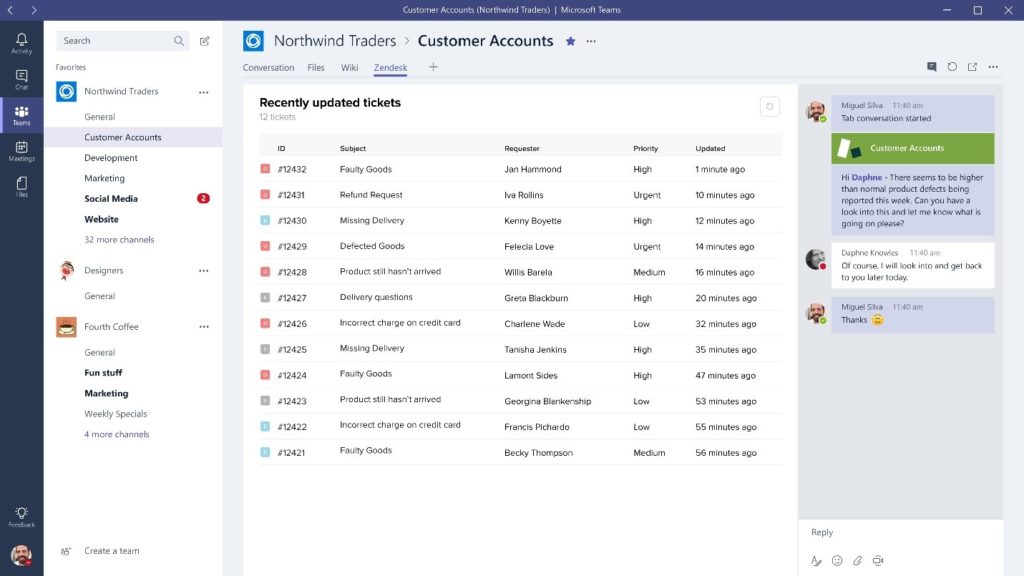
© 2021 Zendesk. All rights reserved.
Zendesk is a popular program among organizations providing subscription services. This is a simple but highly efficient helpdesk tool with an emphasis on multi-channel connection. Zendesk enables you to interact with your customers via live chat, email, social media platforms, telephone, and more. It provides a centralized location for all your customer support relations, making communication authentic and efficient. The Zendesk approach to unifying customer support is impressive, simplifying and streamlining the entire experience for agents and customers alike.
Zendesk also offers support for support mechanisms. In other words, it provides utilities specifically designed to help your support agents, making their jobs easier and the support they offer more productive. This entails giving support agents relevant and detailed information to help them do their jobs better. Moreover, the helpdesk interface on the agent’s end is dynamic, unified, and easy to use.
The Zendesk ticket management system allows customers to submit queries through a range of channels, including email, chat applications, social media, and web forms. All queries are contained within the centralized console, meaning support agents don’t have to hop between platforms and are less likely to accidentally overlook any queries.
This helpdesk software tool is very customizable. You can create macros and share them between agents, and personalized responses can be saved as standard replies, saving time when recurring queries come up. Query views can also be customized, so agents can choose to view tickets in a queue organized according to assignee, group, the status of the ticket, or other parameters. In addition, Zendesk offers an applications marketplace with more than 500 apps and integrations, so you can make the helpdesk your own.
Zendesk recognizes the importance of collaboration and boasts functionalities designed to help your team work together. All agents can collaborate with one another, sharing information via private comments, as well as being able to see who’s viewing a ticket at any given time. This helps to reduce the chance of agents colliding or working on the same ticket at the same time.
I like Zendesk’s approach to self-service, which is very comprehensive. There’s a help center, which can be customized, as well as a thriving online community and a knowledge base. These tools facilitate customers helping themselves, which reduces the time they spend with your agents. There’s also a customer portal, where they can manage their own support requests and view their contributions to the Zendesk community and knowledge base. The portal empowers customers, giving them a hub for all the information they might need.
Zendesk’s Answer Bot, powered by AI, is another cool feature. The bot can automatically reply to support queries by providing links to help center articles. Often, Answer Bot can provide the answer on an agent’s behalf, which saves time.
Zendesk is a favorite among cloud storage providers and software-as-a-service companies. It’s also appropriate for use by in-house support departments. Its availability on the cloud means it can be accessed from anywhere, provided you have internet. There are benefits and disadvantages to this approach. On the one hand, it doesn’t matter which operating systems are used in your organization; on the other, some administrators prefer not to use cloud-based programs, which depend on the internet connection speed and can be prone to lagging.
10. BeyondTrust
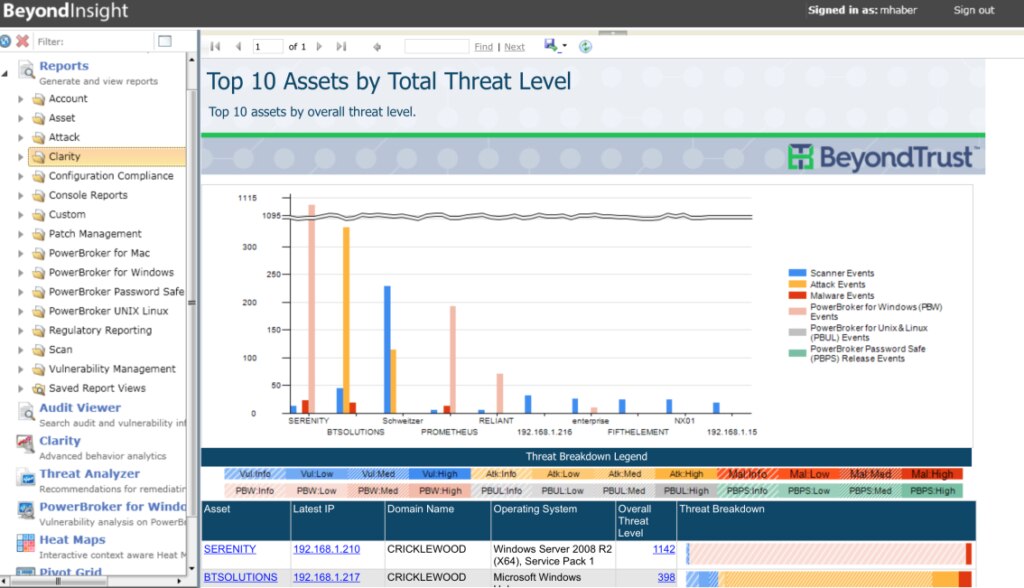
© 2021 BeyondTrust. All rights reserved.
BeyondTrust (formerly Bomgar) is a feature heavy helpdesk software tool. One of the many things I like about it is the flexibility it offers, giving you the opportunity to host the tool either on premises or in the cloud. BeyondTrust is a specialist program with a focus on centralized helpdesk teams. It offers support for both external customers and to your own staff, who might work in different departments or locations. This program unites all your staff, making them more efficient, productive, and collaborative.
With BeyondTrust, you can support remote clients over the internet, but this makes security a greater concern. The tool prioritizes security by enforcing a least-privileged security posture and by implementing granular roles and permissions settings, as well as session policies. By giving your technicians access to the fewest privileges necessary, you will see a knock-on effect impacting the security of the entire system. It ensures access to secure information and features is as minimal as possible, which makes internal security breaches less likely and identifying the source of a breach far easier.
Session policies let you alter the permissions associated with remote support sessions. These permissions can be determined according to the support portal used, or they can be affiliated with a certain supported endpoint. Essentially, the permissions are responsive and change according to defined circumstances. This sets the tool apart from most other remote support software, which requires all sessions to be identical. With other software, while you might be able to remotely control a computer, it’s unlikely you’ll be able to make sessions dynamic and flexible to accommodate changing scenarios. With BeyondTrust, you can use over 50 permissions to define how customers, representatives, and remote systems communicate on a granular level.
Beyond dynamic session policies, BeyondTrust enables you to implement multi-factor authentication, requiring users to authenticate themselves before the session can go ahead. This capability is included for every user. BeyondTrust can also be integrated with the add-ons Vault and Password Safe to import your credentials instantly, without compromising security. (The user can’t see the plain text of the credentials, which would otherwise create a vulnerability in the system.) The best thing about this is administrators don’t have to hunt around for their credentials but can access the system with instant effect and maximum security.
You can’t achieve maximum security without a decent audit trail, and BeyondTrust records all session activity automatically to create a comprehensive and detailed audit log. While these audit logs can be great for identifying the source of a breach, they’re primarily used to prove compliance with regulations. You can also leverage them for staff training.
BeyondTrust offers some remarkable security features. However, the helpdesk itself is less user-friendly and accessible to beginners than many of the other helpdesk support tools on this list. If you want to check out the software, a 7-day free trial is available.
11. Oracle Service Cloud
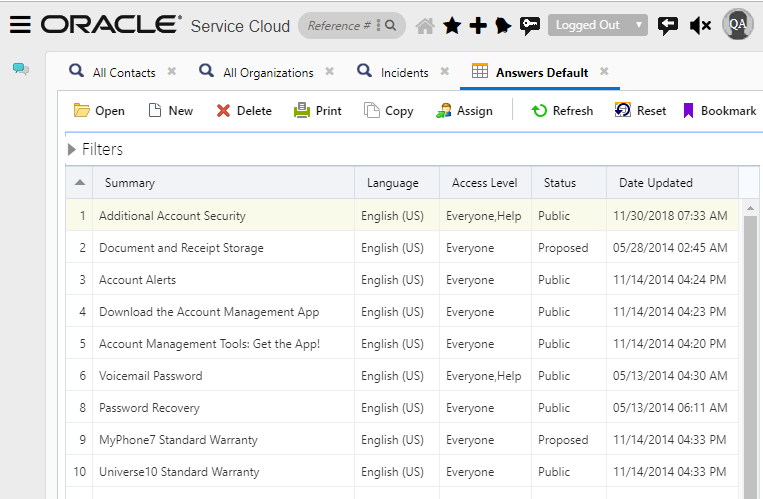
© 2021 Oracle Corporation. All rights reserved.
Oracle is among the biggest providers of service desk software tools, having led the movement toward adopting cloud-based programs. Oracle Cloud supports a wide scope of business processes and functions. Oracle Service Cloud, on the other hand, is a specialist module designed to address your service desk tool requirements.
Oracle Service Cloud is used by in-house teams and by customers and their staff. It is a customizable service with a flexible dashboard, which can be personalized to be divided into separate screens for each role. This is an effective and intelligent feature: it allows team members at a call center, for example, to access the same system used by managers, administrators, and technicians, without creating security risks. Each user can view the functions and data relevant to them, but nothing more, according to the specific screen assigned to their role.
Like all competitive service desk management tools, Oracle Service Cloud can manage multi-channel communication, in the form of phone calls, emails, chat, and web forms. This tool includes a range of functions in support of its commitment to multi-channel interactions, including a searchable troubleshooting system for agents. This helps agents identify a problem when they receive initial calls, potentially saving time and resources.
Oracle Service Cloud also includes a knowledge base utility, which provides agents with details on how to solve a customer’s query in the fastest way possible. The knowledge base can be added to and is intended to reflect recurring or common problems.
If a ticket requires the involvement of a specialist technician, Oracle Service Cloud records all the relevant details pertaining to interactions with the customer, including actions already taken to resolve the issue. This keeps agents from repeating advice by accident. It also saves time and ensures every team member involved in answering the query is fully informed.
If you’re looking for reliable IT helpdesk ticketing tools, then Oracle Service Cloud is worth considering. The program supports interactions with in-house and field queries, by allowing managers to assign certain staff to each, and by offering a troubleshooting option specifically designed for field agents. Managers can automate the allocation of staff to support calls by establishing groups based on competence, such that certain issues can be assigned to the most appropriate and competent group. Thanks to this feature, users are guaranteed the best support available, with little manual labor on your part.
This helpdesk management tool offers live metrics, which can be viewed in the dashboard. It also displays open tickets that are yet to be addressed, so you don’t have multiple agents accidentally working on the same ticket. Within the dashboard, you can establish workflows by laying out a course of action and assigning collaborators to a ticket. The management dashboard will show how each workflow is progressing, giving managers comprehensive oversight of their team’s performance. This also gives managers the opportunity to quickly identify and address any unusual delays to ticket resolutions.
In terms of saving time and labor, Oracle Service Cloud is impressive. For example, logging and archiving functionalities can be automated, and the program features a bank of standard reports, so you don’t necessarily have to make your own. These reports can be customized if preferred.
Users of Oracle Service Cloud benefit from a clear pricing model, in which you never pay for more than you need. It’s a subscription-based service, charged per agent.
12. Apptivo
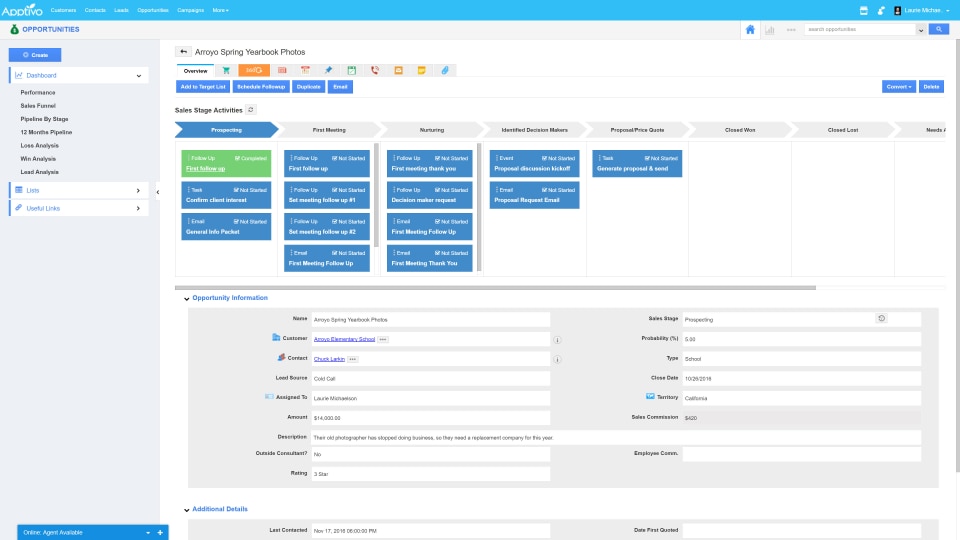
© 2021 Apptivo. All rights reserved.
Apptivo offers an all-in-one solution with a helpdesk management tool, which is accompanied by a number of helpdesk applications. These include Answers, Testimonials, Customers, Contacts, Opportunities, Cases, Documents, Notes, and Email. I’ll outline the basics of a few of these apps to give you a sense of what they entail.
- Answers: The Apptivo Answers App provides a platform for both your team members and your customers where they can pose queries and learn from one another. Within the Answers App, you can devise your own knowledge database, where you can store information and instructions regarding your product, service, and possible issues. The knowledge base facilitates self-service among your customers. By giving them tools to address basic queries and issues themselves, you’ll save your team time and resources. The app lets you edit answers at any time and add useful pictures, hyperlinks, and more. It supports instant notifications, so you’re alerted immediately whenever a question or answer is posted, edited, or removed. You can receive these alerts via your news feed or email. The app can be customized—you can define custom fields, add or delete fields, and design the creation page. You can also personalize the layout of any searches you conduct.
- Testimonials: The Testimonials App is all about collecting and showcasing reviews from your customers. It’s a great marketing tool that, like the Answers App, supports instant alerts when a new testimonial is posted, and allows you to customize the console view.
- Customers: The Customers App is a customer management tool in which you can store and manage your customer details in one centralized location. Equipped with this information, you can make informed outbound sales calls, send emails, and devise an appropriate wider marketing strategy. This app lets you create new customers automatically based on emails you’ve received, add them manually, enter them via API, or import them from a CSV spreadsheet. It supports the creation of email templates, to save you time, and can be synchronized with G Suite. Apptivo also comes with some impressive CRM software features, including lead capture, conversion, management, and sales tracking.
The above mentioned apps are all part of the wider Apptivo helpdesk offering, and they come together to form a comprehensive and powerful IT helpdesk tool. Although many administrators will prefer a tool with a unified solution without the need for apps, others will value the flexibility Apptivo offers, and you can essentially build your own tool.
Apptivo integrates with G Suite, Office 365, Slack, QuickBooks, Google Tasks, and more. The mobile application, available on Android and iOS, is impressively designed, and Apptivo itself is highly compatible with the mobile format. When you download Apptivo on your mobile device, you’ll get the following apps in a single interface: CRM, Invoices, Work Orders, Timesheets, Projects, Estimates, Expense Reports, and Help Desk.
Apptivo uses a subscription-style pricing model. You’ll pay per agent, per month. A 30-day free trial is available.
13. Dezide
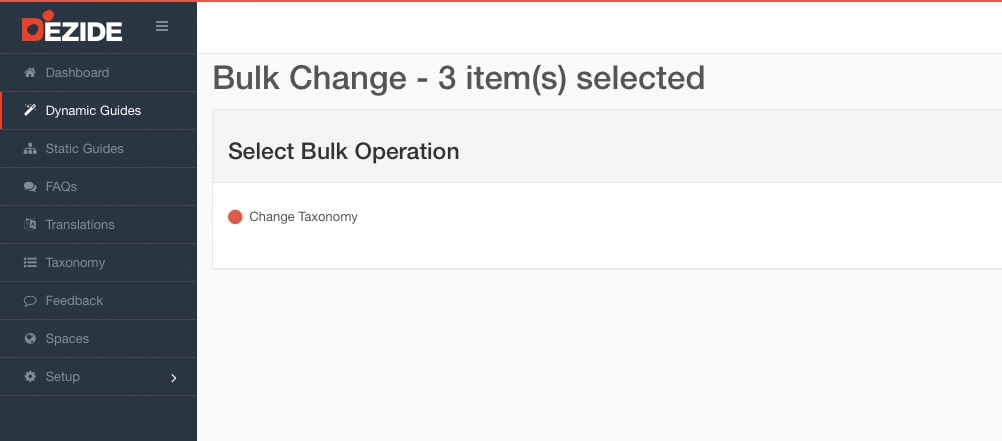
© 2021 Dezide. All rights reserved.
Dezide is another program with hosting flexibility, giving you the choice of using it as a cloud-based platform or on-premises. This tool is designed for Windows, and it has a lot of competitive features. One of its best utilities, in my view, is the ability to create your own specialist, technical guides. These guides can be used for different purposes, including enabling end users to help themselves, in addition to providing field agents and service engineers with offline digital content.
Dezide describes itself as a “technical guided troubleshooting platform.” It’s powered by AI and has been designed to reduce the time spent troubleshooting, resolve problems upon first contact, and transfer skills to new staff quickly and efficiently. Dezide is such an effective troubleshooter because developers have been capturing expert troubleshooting knowledge across the past 20 years. This experience has given them a large and powerful stockpile of expertise, which their program constantly draws from and feeds into. In fact, Dezide claims technicians using this program can solve complicated problems up to 70% faster than with other technologies.
Dezide includes four key products as the bedrock for its overall troubleshooting functionalities. There’s Self Service, Field Service, Remote Service, and a set of APIs. I’ll break down each of these components below.
- Self Service: Dezide’s self-service technology was designed to address the fact that most users prefer to solve problems themselves, rather than having to connect with an agent. The self-service workflows give users access to troubleshooting guides aimed at helping them work out the answer to their query on their own. Users can also access these guides via the mobile application. The program’s troubleshooting guides are interactive and tailored to the needs of your end users by differentiating among levels of skill. One of the best things about Dezide’s self-service module, in my view, is if the user tries and fails to solve the problem, they can transfer a record of their entire troubleshooting history directly to the service agent. This way, the agent will know not to advise the user to try things they’ve already tried. All user interactions are captured and can be used in the future to inform the wider knowledge base. This means Dezide is always evolving and collecting information to help future users.
- Field Service: Next, there’s the Field Service module. This is the dashboard through which service technicians work. With Dezide, technicians have access to dynamic troubleshooting guides, which include real-time instructions broken down into simple but detailed steps. Dezide’s AI-powered platform accounts for root cause probability, the likelihood of corrective actions being successful, repair costs, and the time needed to complete the corrective actions. It uses these factors to inform the troubleshooting recommendations.
- Remote Service: The Remote Service technology empowers your service center personnel by standardizing the knowledge base and automating processes. With this technology, call center agents are more likely to provide technicians with accurate, helpful information.
- Developer APIs: Dezide provides APIs for developing your own applications, which can be used to integrate the helpdesk solution. These APIs allow users to create customized troubleshooting experiences.
Dezide offers both cloud and owned versions. It uses a subscription-based pricing model, which means you don’t pay for more than you need.
14. BOSS Support Central
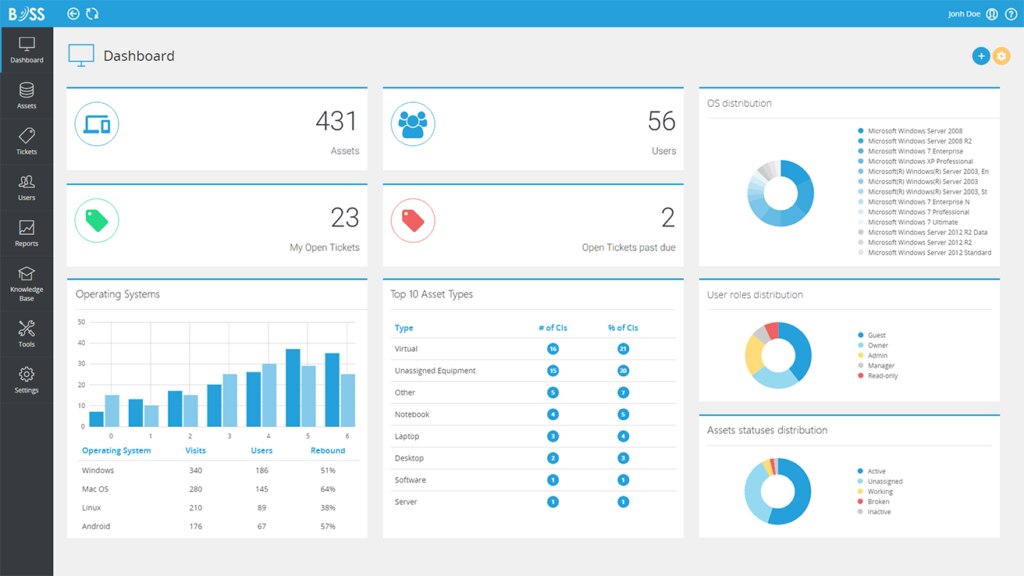
© 2021 BOSS. All rights reserved.
If you’re looking to combine helpdesk utilities, IT asset management, a service catalog, and reporting functionalities, then BOSS Support Central is one of the best helpdesk software tools available. This is an on-premises program, but there’s also a cloud-based package available, called BOSSDesk.
BOSS Support Central has a lot to offer: it’s extremely secure, simple to use, easily upgraded from older versions, and cost-effective overall. It requires minimal training, which is another cost-saving aspect. This program is ITIL aligned, with a focus on ticket management, asset management, reporting, self-service, configuration, and the service catalog.
With the tool’s ticket management utilities, users can submit and track service incidents and requests. Departments can manage tasks both independently and collaboratively via the workflow or routing engine, which assigns tickets to the appropriate agent or department automatically. The routing engine creates a workflow requiring little to no manual intervention. Tickets can be scheduled ahead of time to boost preventive maintenance processes, the backing up of data, and other routine activities. In addition, you can establish criteria to determine how issues are escalated, which is also an automated process.
Because of the combined IT asset management functionalities, BOSS Support Central can address system configurations to solve a user’s issue. This useful feature allows you to merge systems administration and the service desk into a unified department. Alternatively, you could make the ticketing system accessible to your agents in the admin department. This makes the whole process more efficient and collaborative.
The customizable service catalog is another aspect worth mentioning. The service catalog allows users to post service requests through a single platform. It lets you customize forms addressing the requirements of specific user categories, and the appropriate form is shown to the appropriate user based on the parameters of their group—whether the group refers to their department or an Active Directory security group.
Customization utilities can be hit or miss with ticketing tools in IT, because the design is so easily overlooked. BOSS Support Central uses a form designer that’s easy to use, with basic drag-and-drop functions. The interface can be integrated with routing rules, and the custom form lets you define whether a request should be routed for approvals, to an expense board, or to an approval board.
While the form designer is an impressive and easy-to-use utility, BOSS Central Support would benefit from being more user-friendly in general and streamlined between users and agents.
This tool is available in the form of a mobile application for both Android and iOS, so agents can access the system from anywhere. There are three packages, the least expensive of which doesn’t include ticketing utilities. BOSS Support Central is priced on a subscription basis, per agent, per month. You can request a personalized demo to get a better sense of the tool.
15. Help Scout
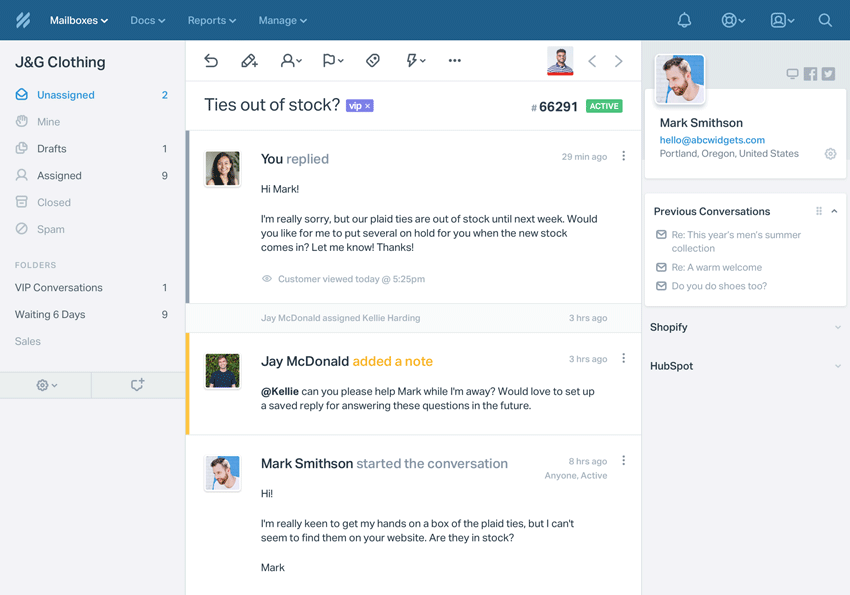
© 2021 Help Scout. All rights reserved.
Help Scout is another tool with lots to recommend about it. One of my favorite features is the multiple mailbox capacity—this is Help Scout’s solution to the difficulty involved in collaborating among numerous departments across inboxes and shared emails. With Help Scout, you can have multiple mailboxes for each shared mail address. This means there’s no collision between agents or departments, and you can manage multiple products and brands from a single account.
In general, Help Scout makes collaboration easy. While many tools only offer one or two utilities designed to facilitate collaboration, Help Scout boasts several. You can leave private notes using the @ symbol to mention and tag others, in the style of many popular social media platforms. There’s also the ability to save replies, so when a common question comes up you can answer it in just two clicks of the mouse.
Collision detection is another intelligent feature, giving you real-time visibility into who’s viewing or replying to a query. Last of all, tagging allows you to categorize conversations. These tags then inform reporting and automation, making everything faster, streamlined, and more traceable.
Every helpdesk tool adopts its own approach to workflows. With Help Scout, the workflows feature allows you to establish automated activities based on an if/then approach. For example, an automated action might be based on the following if/then conditions: “If X contains Y, then assign to Z.” In practice, this might look like: “If subject contains invoice, then assign to Troy.” These automated elements are highly flexible and customizable, extending far beyond who tasks are assigned to. You could even create a rule like, “If subject contains invoice, then assign to Troy and add the tag billing.” These automation rules can be quite elaborate if you want them to be.
You can use these rules to send bulk replies and create custom folders. For instance, if a conversation has the “outage” tag, you can have an automatic email be sent to the customer and the status edited to “closed.” Or you could determine if an active conversation has the “refund” tag, it should be copied to the “refund requests” folder. As I see it, these automation rules are a great idea, but they’re difficult to implement in practice. They save time when effective but having such concrete rules with automated activities attached to them has the potential to create new issues.
Help Scout comes with more than 50 integrations, which can be injected into your current workflow. These integrations include HubSpot, Jira, Trello, JustCall, and Salesforce. A free trial of Help Scout is available.
16. TOPdesk
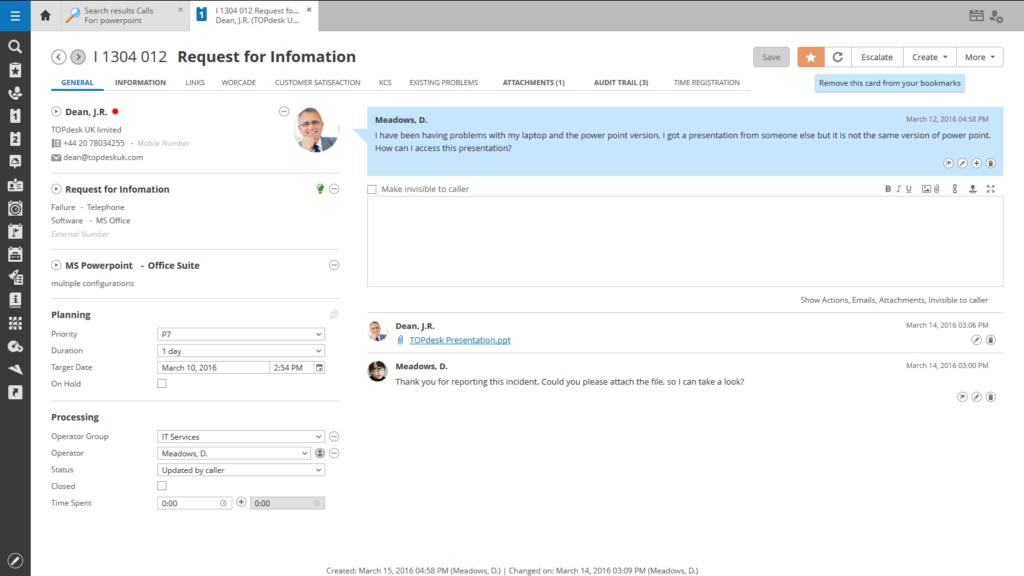
© 2021 TOPdesk. All rights reserved.
TOPdesk’s ITSM solution is great for IT administrators looking for successful helpdesk tools. It offers a combination of change and release management, asset management, intelligent dashboard and reporting functionalities, incident management, operations management, and problem management, along with a self-service portal for customers, request fulfillment, resource management, knowledge management, service catalog management, and supplier service management. In other words, this is a highly versatile tool.
With TOPdesk, registering and processing incidents is quick and easy. You can assign incidents to an operator or supplier within a few seconds. The self-service portal is a great feature, giving end users access to FAQs and a knowledge base, along with the capability to log and track calls. Having these effective self-service mechanisms in place will save your agents time.
TOPdesk’s configuration management module manages all your hardware and software assets, with icons for each to make differentiation simple. The module can be broken down into the following tabs: General, Information, Private, Contract, Graphic Overview, Person Group, Objects, Images, Links, and HR. You can have separate tabs open in the top bar of the dashboard—for example, you might have a task board open for the current week, with another tab displaying the operator’s profile. This design means you can move between batches of information quickly and smoothly, without disrupting clarify of interpretation.
The dashboard and reporting features are key contributors to the success of any helpdesk. TOPdesk uses a single dashboard for all KPIs and reports. Within this dashboard, you can design your own reports, which can include pie charts, line graphs, and other graphical representations of your data. While the dashboard unifies all the information you need access to, it could be more dynamic. Moreover, it takes a while to get used to where everything is, because of the quantity of tabs. The resource management utility is another notable feature of this tool. It gives you insight into workloads, so you can adjust schedules accordingly and prevent departments from becoming overloaded. It also gives you visibility into who’s working on what. With this module, you’re able to quickly assign new tasks to your team with a simple yet effective drag-and-drop functionality.
TOPdesk pricing is based on the functionality desired, as well as either the number of callers your organization serves or the number of service agents you employ. If you want to give it a try, a 30-day free trial is available. They don’t ask for your credit card details, so you don’t have to worry about overlooking the last day of the free trial period and landing yourself a bill.
17. Dixa
One of the great things about Dixa is how quickly you can get up and running. In just 15 minutes, you should be ready to test channels, and you’ll need nothing more than an internet connection to do so. Easy setup is a clear benefit of a cloud-based platform like this one, though as mentioned before, not everyone trusts cloud-based programs. The disadvantage is there’s always the chance your internet will fail, and you’ll lose access.
With Dixa, customer chats can be routed to specific agents, and you can integrate customer data from your own systems, so a customer is instantly recognized, giving agents visibility into a customer’s past queries, for example. This provides the agent supporting a customer with all the information needed to get started.
Intelligent email routing is sophisticated but simple with Dixa. You won’t need multiple inboxes or waste time categorizing individual emails—Dixa does all this for you. This utility prioritizes critical customer queries over non-urgent queries according to content-based rules created by you. Essentially, you decide what constitutes a critical query and feed it into the system, which then automates the routing process for you.
This solution also supports automatic replies, which can be sent to customers both within and outside of traditional working hours. Auto replies can answer common queries for customers, so they may not even need to connect with an agent. Dixa also tracks topics by applying tags to emails on an automated basis, according to their content. This is a fantastic time-saving utility.
I really like the Dixa interface, which is dynamic and colorful, but uncluttered. It makes viewing tickets and their priority level super simple. Dixa also supports voice calls, with callback, call recording, automated call distribution, VoIP, and numbers in over 60 countries. For email, Dixa provides automatic routing to agents, rapid response rates, automated replies, use of company email addresses, and custom signatures.
The chat solution offers skill-based routing, rapid responses, media messaging, and an offline contact form, with the capacity to set online hours. Lastly, it lets you connect with customers through Facebook Messenger, with automated routing, quick responses and follow-ups, tags, and direct transfer to a queue or an agent.
Dixa offers three plans, each priced per agent, per month. There’s no free trial, but you can book a one-on-one demo with a member of the Dixa team, and they’ll explain how Dixa might work for you.
18. Acquire
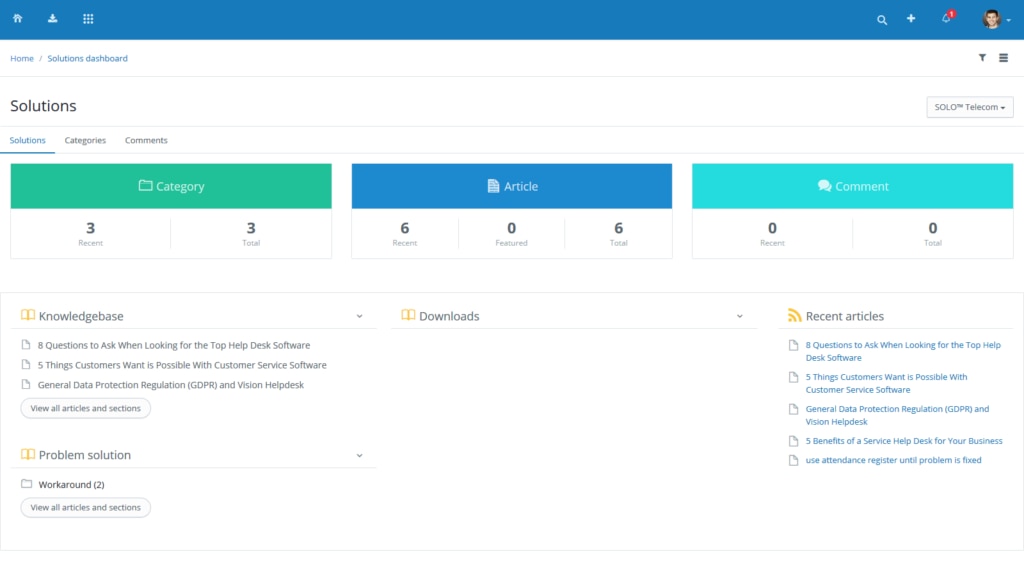
© 2021 Acquire. All rights reserved.
Acquire isn’t primarily an IT helpdesk tool, but it certainly can be used as one. Although this program was designed for sales departments, the value of the customer support utilities extends far beyond sales.
The live chat functionality is my favorite Acquire feature. It goes beyond the average real-time web chat channel by enabling screen sharing, voice calls, and video calls. These features make communication between customers and agents easy, extremely efficient, and highly flexible. It can be hard to understand someone in plain text format, making miscommunications a common occurrence. With the voice call and screen sharing options, everything becomes much clearer.
Acquire supports automatic messaging, which responds to common queries instantly without any agent involvement. Another thing I like about Acquire is its dashboard. On the visitor’s end, the dashboard is dynamic but uncluttered. Visitors can open a chat or start a new chat easily, and view which agent is working on which of their queries. You can also customize the chat widget your customers see, so it fits with your overall brand.
Automation pervades the Acquire experience, which is a big benefit. Even the words being typed by an agent can be automated, with the AI making smart, informed suggestions based on previous responses. These auto suggestions can save you time. You can scroll through canned messages and choose whichever you like. For example, instead of typing out, “Hi. How can I help you?” you could choose it from your list of canned messages and automatically send it. Acquire can also automatically allocate chat requests to certain departments and distribute chats evenly across team members, so no one is overloaded.
Collaboration is a key contributor to any successful helpdesk. Agents should be able to talk to each other in a traceable and easy way. Acquire does a great job of facilitating this, allowing team members to add internal notes to a chat. Notes are viewable to other teammates, but not to the customer. By leaving these notes, other agents know what point you are at in the resolution process, so there’s no overlap.
With Acquire, you can access customer profiles and track visitor activities. This affords you insight into how your customers behave and what they expect from you, as well as patterns and trends. At the end of chats, Acquire lets you send a feedback request. It’s nice and simple, with emojis used to describe the customer’s overall experience of the support received. As I see it, customers aren’t likely to take time out of their day to fill in a long-winded feedback form, so this emoji-based system is a good idea.
Acquire is a cloud-based platform offering three service packages, billed annually on a per agent, per month basis. These include the Basic package, which functions nicely as a ticket management solution. It includes proactive messaging, video and voice calling, chat SDK, compatibility with multiple languages, basic integrations and analytics, basic routing, a sales bot, screen sharing, customer profiles, live chat, and co-browse capabilities. The Pro version combines all these features with a smart bot, Salesforce and Zendesk integration, a knowledge base, recordings and auto suggestions, intelligent routing, team analytics, and multi-communication channel compatibility, among other features. For the Enterprise package, which has a custom pricing structure, you’ll also gain access to APIs, smart bot and dynamic answer, a staging and development environment, audit logs, SSO, account-based marketing, contextual analytics, and a dedicated server.
I’d recommend the Pro version, as a minimum, if you want a top service desk tool. To give Acquire a try, you can book a demo with one of the team members.
Tools for Managed Services Providers
Most of the above options are general-purpose tools, which means they are useful for a wide range of situations and environments. However, there are certain types of users that can benefit from more targeted solutions.
For managed services providers (MSPs), this means finding a tool that simplifies and streamlines help-desk support. MSP Manager could come in handy. This specialized solution wasn’t included in the above list because it’s designed with the unique needs of MSPs in mind.
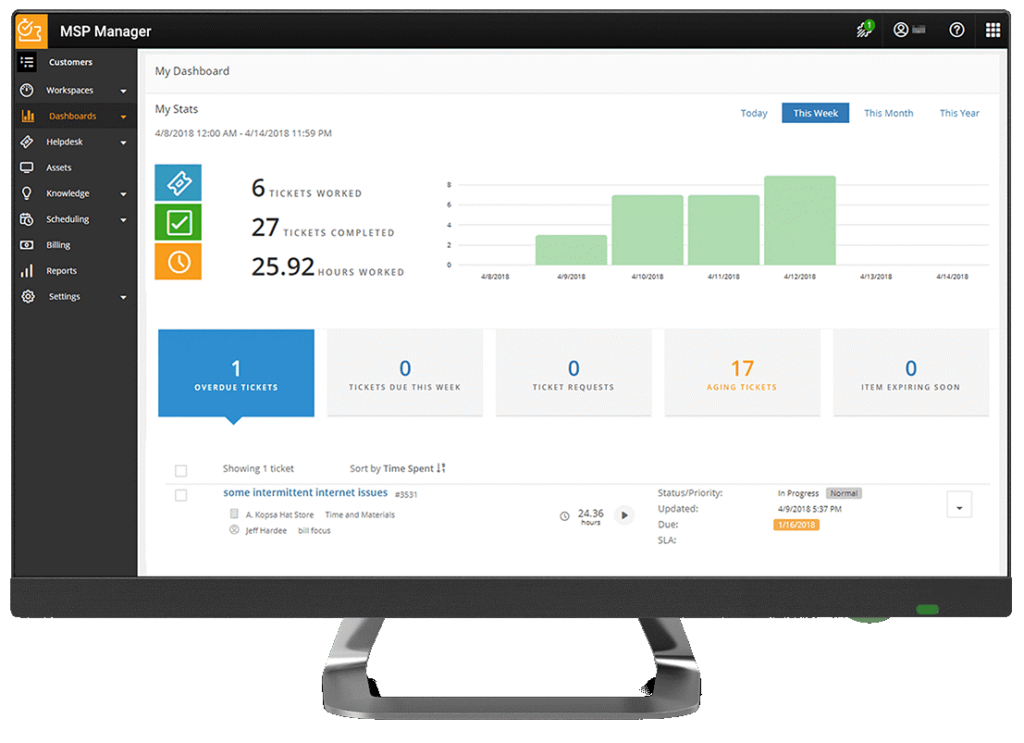
© 2021 SolarWinds Worldwide, LLC. All rights reserved.
With MSP Manager, you get access to a full feature set for helping your customers while minimizing the work involved. This includes an intuitive and streamlined ticketing process, a brandable customer portal, a dedicated mobile app, and much more.
The Best Service Desk/Help Desk Tool
With the wide range of IT helpdesk tools on the market, choosing one can begin to seem impossible. I hope this guide has given you a clear idea of the features you need for your business, and which tool or tools fit the bill. For Windows users, whatever your service desk tool requirements, you can’t go wrong with SolarWinds Service Desk, a versatile, user-friendly solution with an intelligent design and sophisticated features.

